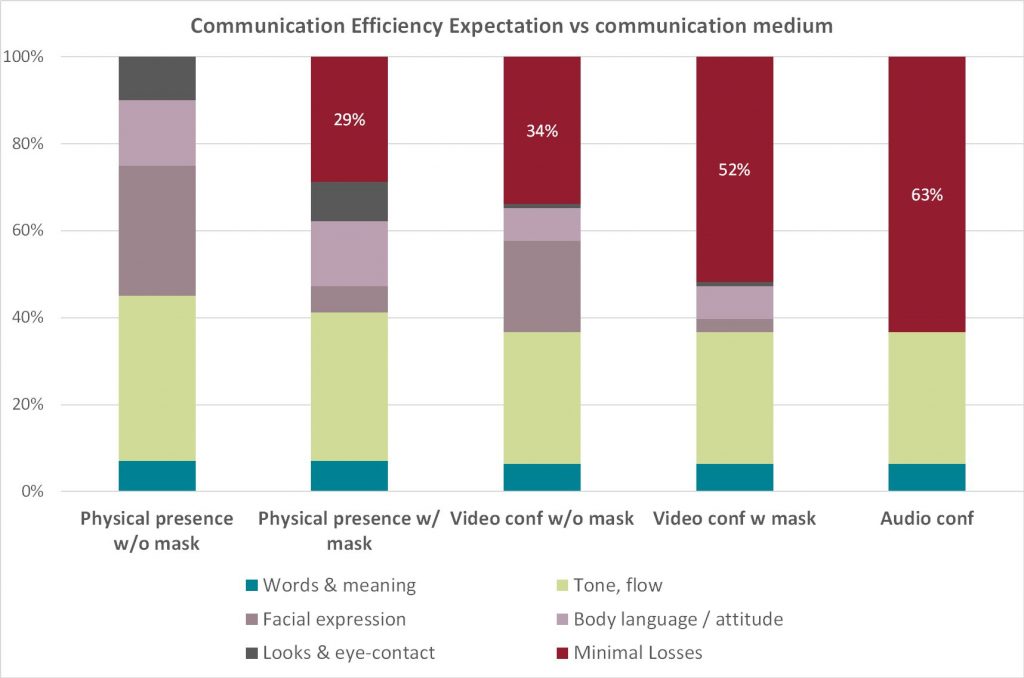It is an understatement to write that the sudden outburst of the pandemic, 8 months ago has deeply impacted our way-of-life, and that the shockwave is still propagating –and will continue for months if not years.
As a cross-cultural Project Manager, I heavily questioned the way we are working and tried to quantify the consequences on the numerous meetings I have to attend.
As a good French-born engineer and Excel maniac, I obviously focused on negative ones, and tried to put them in a table.
In terms of communication, it is commonly accepted that pure verbal transmission represents only 7% of total communication between individuals, while para-verbal (tone, flow…) and non-verbal ones (gestures, facial expression…) carry respectively 38% and 55%. Within the last figure, my own experience (or sensitivity) leads me to consider that 30% transit through facial expression but eyes, 10 % through eyes and looks, and about 15% through gestures and body language.
Then I have assessed in 5 different meeting situations, the maximum communication efficiency you can expect:
- The reference: face-to-face, physically present in the same room, at a social distance. Theoretically, you can reach 100% for each factor.
- The same, wearing a mask. In this case, facial expressions are difficult to catch, and without us being conscious of it, our tone and flow are slightly distorted
- Videoconference with and without a mask, which results in a massive loss in body-language and eye-contact
- Audioconference, where everything but verbal and para-verbal is completely unperceivable
Here are the table and the chart showing the results:


More than the accurate figures that could be challenged, the takeaways of the above are roughly:
- Masks are cutting about 30% of our communication possibilities
- While videoconference looks attractive, the loss in terms of understanding even with non-masked attendees is very comparable : 1/3 of communication chances are cut
- It worsens dramatically if you are wearing a mask during the videoconference meeting: half of the potential is lost
- Finally, audioconference weakens communication efficiency by not less than two thirds.
The purpose of the above is not to over-dramatize the present crisis, but to keep in mind the 3 or 4 striking figures above in order to adapt our behavior, as we will still be forced to live with this situation for months, if not years.
From AppTek’s perspective, and to minimize impact on Project Management, I have drawn the following rules:
- Organizing physical meetings with several people wearing a mask will not bring a significant advantage compared to a videoconference without masks.
- When holding videoconferences, it is better for all participants to isolate at their working desk, even if some of them have the possibility to share a common meeting room, with the condition to wear a mask.
- Whenever possible, organizing meetings without masks in safe conditions (like an open-air space especially set-up for this, or at a pub or restaurant terrace) will minimize the potential losses in communication.
Revenge note: this is where French, Italian or Chinese people, with their “bad” habits of endless social meals take their advantage: in proper safe circumstances and social distancing, restaurants may become the new place where meetings can be held, with maximum ROI.
The second conclusion we have to draw from this is that, more than ever, we have to take care of the clarity, conciseness of our words, be very attentive to our colleagues’ or partners’ reaction, and encourage them to provide some formal feedback.
For those who are familiar with cross-cultural environment, the above conclusions seem strangely familiar, as cultural codes variations have often exactly the same consequences: body language, facial expressions and para-verbal aspects are often difficult to decode when you do not have the right keys. An example is the rhythm of exchanges in German, where, due to grammar, it is necessary to wait for the end of the sentence to understand it properly. Thus, answering too fast may result in completely missing the point.
Another one: the very tonal nature of Chinese language may mislead some French listeners to a wrong interpretation of the speaker’s mood. French is in standard a “flat-toned language”, where the tonal inflexions are mainly used to express feelings. Thus, numerous tone variations in Chinese can sound as anger, satisfaction, or whatever (wrong) feeling while in fact, Chinese is just not understandable without respecting these tones.
The above is for para-verbal, but think of the difference between Latin cultures, often using much body language, sometimes to express things that are NOT said, and Northern ones where body movements may be considered as expressing lack of serenity, or even impoliteness.
If you draw the parallel, even your own language becomes harder to understand through audio or video conferencing systems, despite the huge improvement seen in recent years. Facial expression, relying on eyes only becomes as tricky to interpret as your Japanese colleague ones, and how could you perceive body language through a single thumbnail picture?
To take the best of this unseen situation, let’s challenge ourselves to deal with our usual correspondents and fellow nationals with the same care, respect and openness we have for foreigners, as sharing the same language is not enough to understand each other!